The world of data and AI is evolving faster than ever. In fact, it’s estimated that 90% of the world's data was generated in the last two years. Because of this seismic shift, it’s imperative for businesses to harness the power of their data, in order to stay competitive in the next generation of digital transformation. And because of our expertise in Postgres, EDB is perfectly positioned to help our customers make the critical shift to next generation operating models.
It’s no longer enough for businesses to be good at delivering excellence in their physical business. In order to stay ahead of the curve, the enterprise of the future must be good at leveraging the data that drives the physical execution of their business.
The move to a digital landscape has been happening for decades, but the COVID virus certainly accelerated this transformation, as every interaction during the pandemic shifted from a face-to-face interaction to an online interaction. In the aftermath of the pandemic, there's a plethora of new data and interaction channels to be leveraged.
The modern data stack is defined by open source
In this new digital and data-driven world, we're using a modern data stack, that is defined by open source.
Some people may read that and think open source is something new, scary, or revolutionary.
Think again.
The transition to open source actually started 15 to 20 years ago.
Most people who use modern technology are on open source today, whether they are aware of it or not. Everybody is using Linux today, and Linux is open source. It has become so general-purpose and ubiquitous that nobody remembers that Linux is open-source. After Linux became mainstream, the proprietary web server disappeared and was replaced by open source. The proprietary application server also disappeared in favor of open source. Open source databases are just the next step in this process. This move to open source is not a revolution. This is not something sudden or new, but a process that started 15 to 20 years ago for every company on the planet and has been highly successful. Hardly anybody is still on Unix or Ultrix, or OpenVMS. They have all moved to open source operating systems, a move which has been very successful. The move to open-source database management systems (like Postgres) is just the next logical step in that process.
This is not a revolution, but a natural evolution.
Developers love Postgres
Postgres is now officially the top choice database for developers. It has been highly favored by developers for many years, as is evidenced by the Stack Overflow survey, which has been conducted annually since 2011. The survey collects feedback from more than 50,000 developers every year, and Postgres was always one of the top players in all the categories of most wanted, most used, most loved. In 2023, for the first time, Postgres was number one in every single category (more than 90,000 developers responded to the survey in 2023).
So in this move to open source for the database, Postgres is the very clear winner.
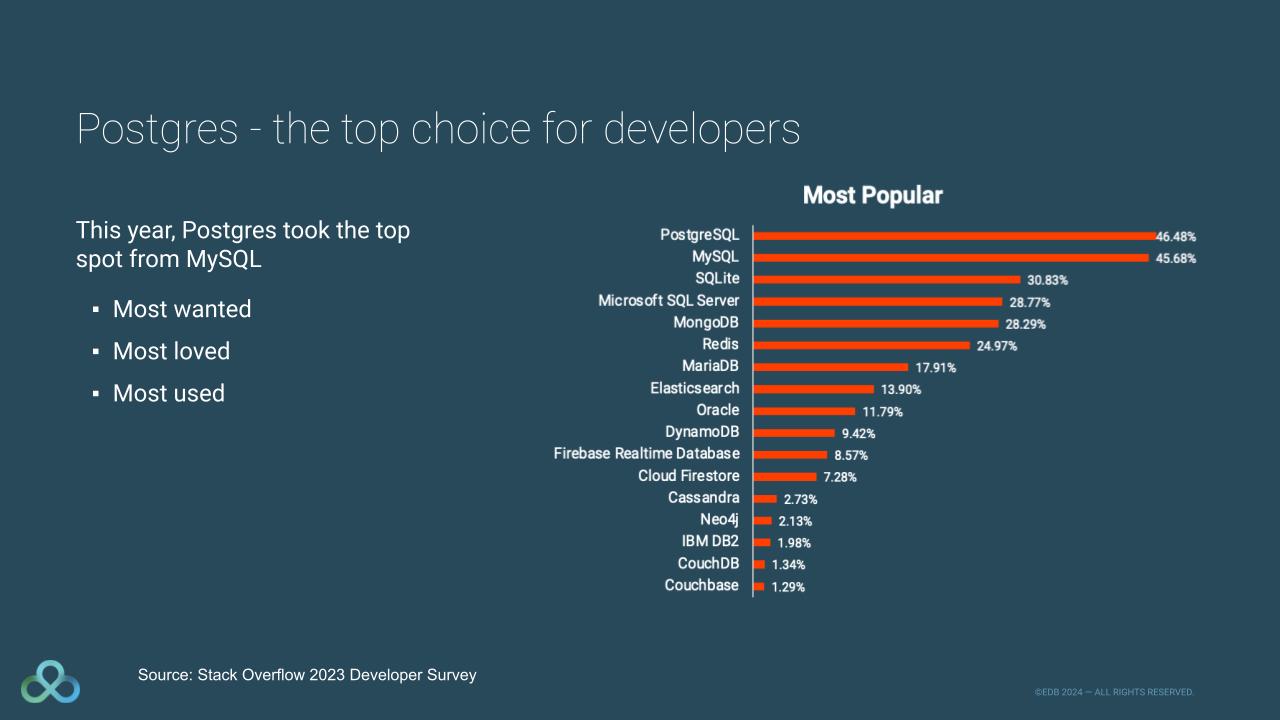
The move to open source happened because Linux was just so much better and so much cheaper than the proprietary operating systems. The same thing is happening with Postgres. Postgres is so much cheaper and so much better than the proprietary options. But those are just two of the major factors that contributed to this successful evolution. Applications must be modernized to stay competitive. Here’s a deep dive into six reasons that modern enterprise applications are different, and why Postgres has emerged as the future-proof data platform for the enterprise.
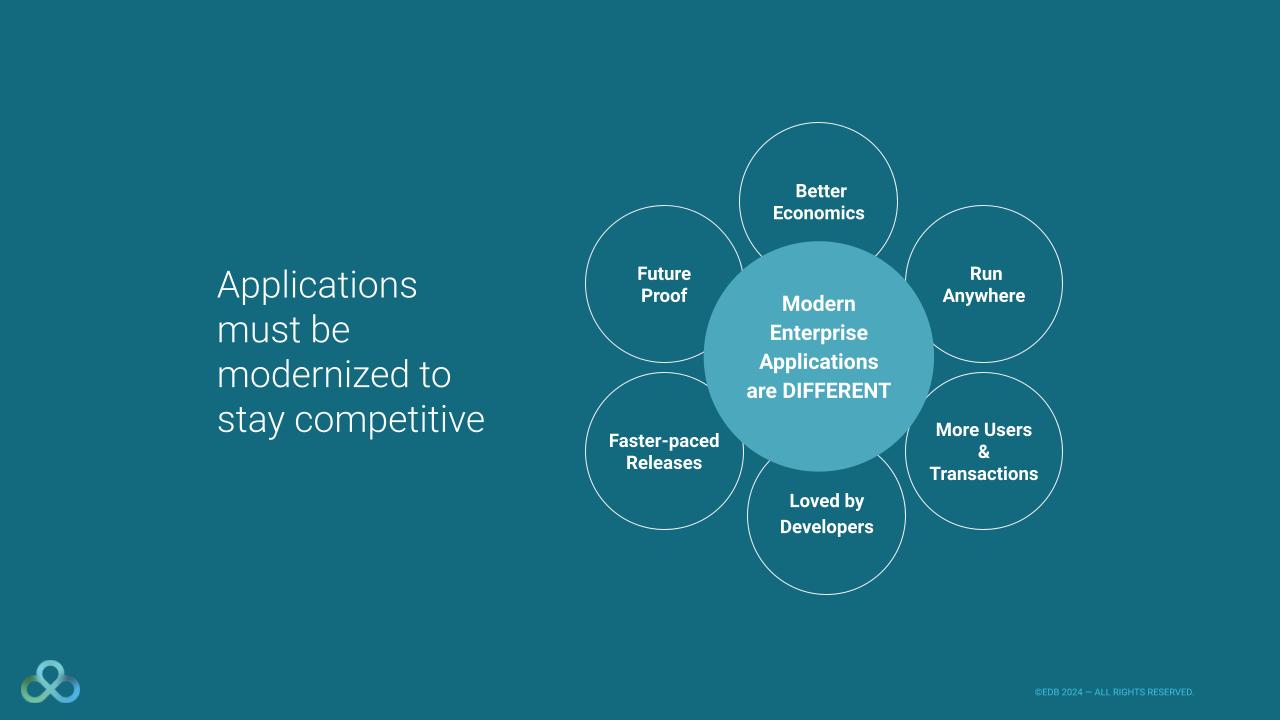
Modern enterprise applications: better economics
Modern applications require better economics. If we're trying to expand a market for a company and that market is driven by digital components, the economics have to be exceptionally good.
Postgres has better economics than Oracle, about 80% cost advantage. And I'm not going to deny that is the major reason people start coming to Postgres. My friend Bruce Momjian, one of the founders of the Postgres community, has a favorite saying that people come to Postgres because of the money, and then they stay because of the innovation.
Modern enterprise applications: run everywhere
Moving your application to the most cost-effective platform can help save the business money, but it has to make sense on the technical side of the business, not just the financial side. And what modern businesses need now more than ever for their database is flexibility. Once again Postgres is the clear winner for enterprises looking to move to a database that runs everywhere. Postgres offers the greatest flexibility, because it runs on every cloud, on every operating system, and on every hardware platform. It’s a unique value, and not many other databases can say the same. Some big players out there will tell you, “Oh yeah, you can take my database to the cloud, but by the way, it's only my cloud.” So your choices are really constrained. Nobody wants that.
Customers want flexibility, and they want to be in control of their data. Postgres is the ultimate solution because it allows the modern enterprise to run its business on the platform of its choice, whether that’s a data center, the cloud, or hybridization structures.
Modern enterprise applications: more users and transactions
It’s impossible to fathom the number of digital transactions occurring every second in our modern digital economy. The latest estimates say about 402.74 million terabytes of data are created each day. That’s why the enterprise of the future needs a database that can handle more users and more transactions than ever before. As we mentioned earlier in the blog, the move to a digital economy has been progressing for decades, and Covid-19 pandemic accelerated that transformation, as businesses saw all of the interactions they had with customers move to the Internet. They have more customers using the platforms, and those customers need to be supported. More customers means more transactions happening with more detail and more data to be collected, stored, and analyzed.
Modern enterprise applications: loved by developers
Choosing the database that developers love most will help bring better developer talent to your business. We already mentioned the Stack Overflow survey, which shows that Postgres is the number one database among developers. And you may think that’s great for Postgres, but why does it matter to a business or enterprise? Here’s another way to look at that superlative: Developers are essential to innovation. If you can't attract the right talent, then you cannot innovate fast enough, which is absolutely necessary in the new economy.
Data shows that open source is a talent magnet.
Creating an environment that attracts the right talent is essential for driving innovation.
By using Postgres you’re attracting the best developer talent to your business, which gives you the competitive edge of faster innovation to accelerate your enterprise.
Modern enterprise applications: faster-paced releases
Postgres has been doing faster-paced releases for 20 years, delivering new major releases every year. Now, other database vendors are finally starting to catch up. For example, Microsoft SQL Server is trying to get to annual releases to keep up with the pace of innovation. But they’re way behind, Postgres has been doing it for decades.
Accelerating innovation can give businesses a critical advantage in the competitive digital landscape, but only if you’re working with a database that’s built on fast-paced releases and frequent updates. That’s why Postgres is the clear choice for businesses committed to innovation.
Modern enterprise applications: future proof
Postgres is the future-proof data platform for the modern enterprise .
I know what you’re thinking: Postgres is 35 years old. How can such an old platform be future-proof? The previous five reasons certainly help make the case. From better economics to flexibility and faster releases, it’s clear to see that Postgres is a strong choice for businesses in the modern digital economy, offering all the capabilities you need for success.
Looking ahead, Postgres is also the ideal platform for next-generation applications that are heavily dependent on analytics and AI. That’s why we built EDB Postgres AI to be the first intelligent data platform for transactional, analytical, and new AI workloads powered by an enhanced Postgres engine. It can be deployed as a cloud-managed service, self-managed software, or as a physical appliance. It delivers built-in observability, AI-driven assistance, migration tooling, and a single pane of glass for managing hybrid data estates.
Developers love Postgres because it supports every data type
Having the ability to work seamlessly with multiple data types enables developers to be more productive. That’s one of the reasons developers love Postgres: because it supports every data type they need to work with, accelerating their ability to deliver new applications.
When it comes to the intersection of multiple data types, there’s no better example than mobile phone applications. Because so many of the applications being developed today run on the mobile phone, they show us the intersection of these three things:
- They interface with the mobile phone using JSON.
- They transact business. From searching to purchasing, it’s a major tool for transactions.
- They use location data.
Postgres supports all of these data types seamlessly. Developers building mobile applications need a database that is mobile-friendly with JSON, allows you to transact, and can leverage location information. And of course, you want that all in one database, all in one place.
Imagine you would do that in three different databases. Now you have three patch cycles, three DBAs, three user manuals, three emergency recovery procedures, three times as many costs and a lot less flexibility. You don't want that. Nobody wants that.
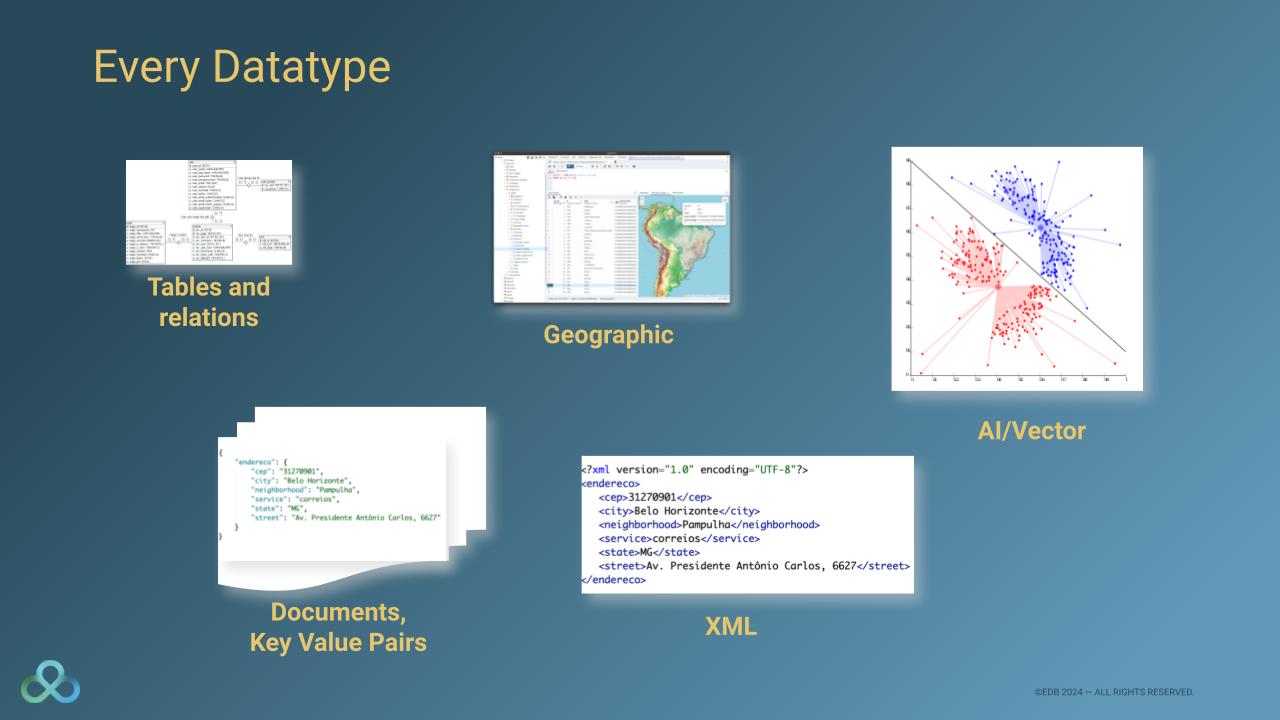
Plus, Postgres is uniquely positioned to be the platform for building the AI applications of the future. In addition to transactions, locations, and JSON data, Postgres also allows you to do vectors and AI calculations, all inside the same database and all with the same talent, the same developer, the same DBA, the same patch cycle, the same hardware, the same procurement cycle, all of that in one place.
It’s easy to see why developers love Postgres, because it gives them great productivity with very little complexity.
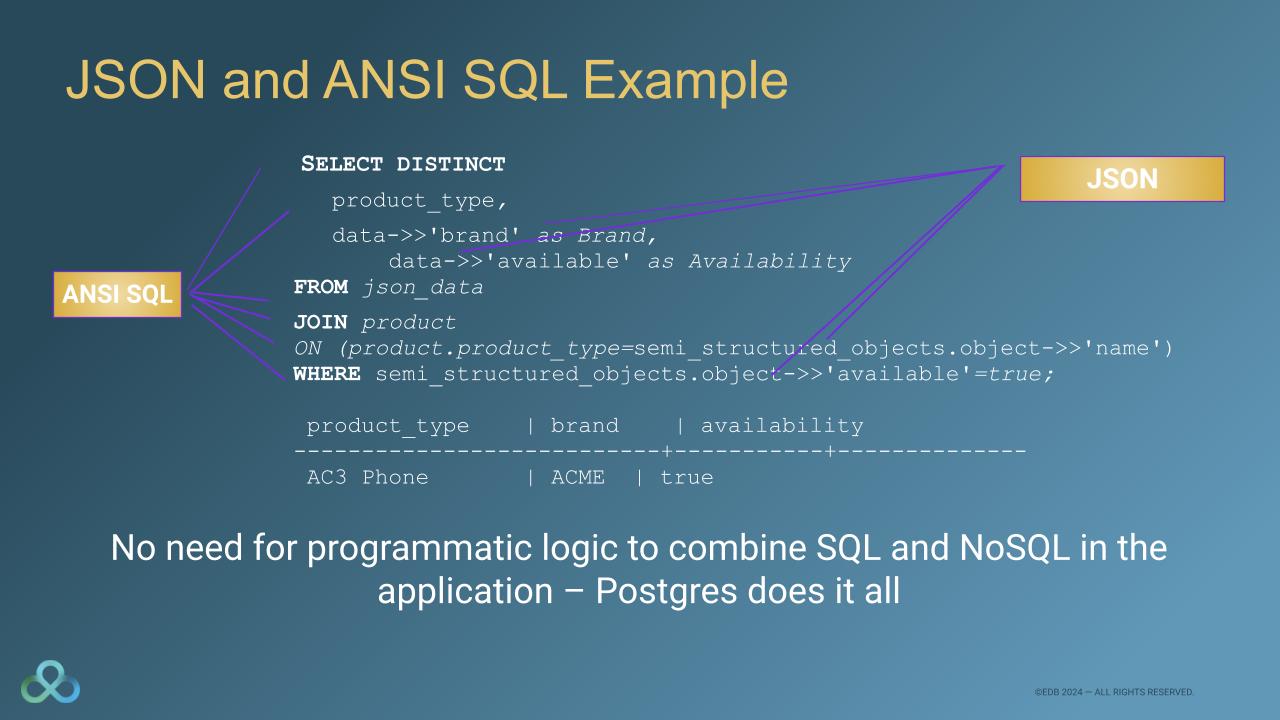
This is JSON, document data and ANSI SQL, standard transactions all tied together. What's interesting here is you see, this is just SQL. There are a couple of little different squiggles in there that you may not have seen before, for example, between data and brand. But overall, this is one transaction, this is one programming language.
Imagine how much productivity you get when you can use a standard thing like SQL that everybody learned about in school, and you can use it to make advanced mobile applications and now also applications that support AI.
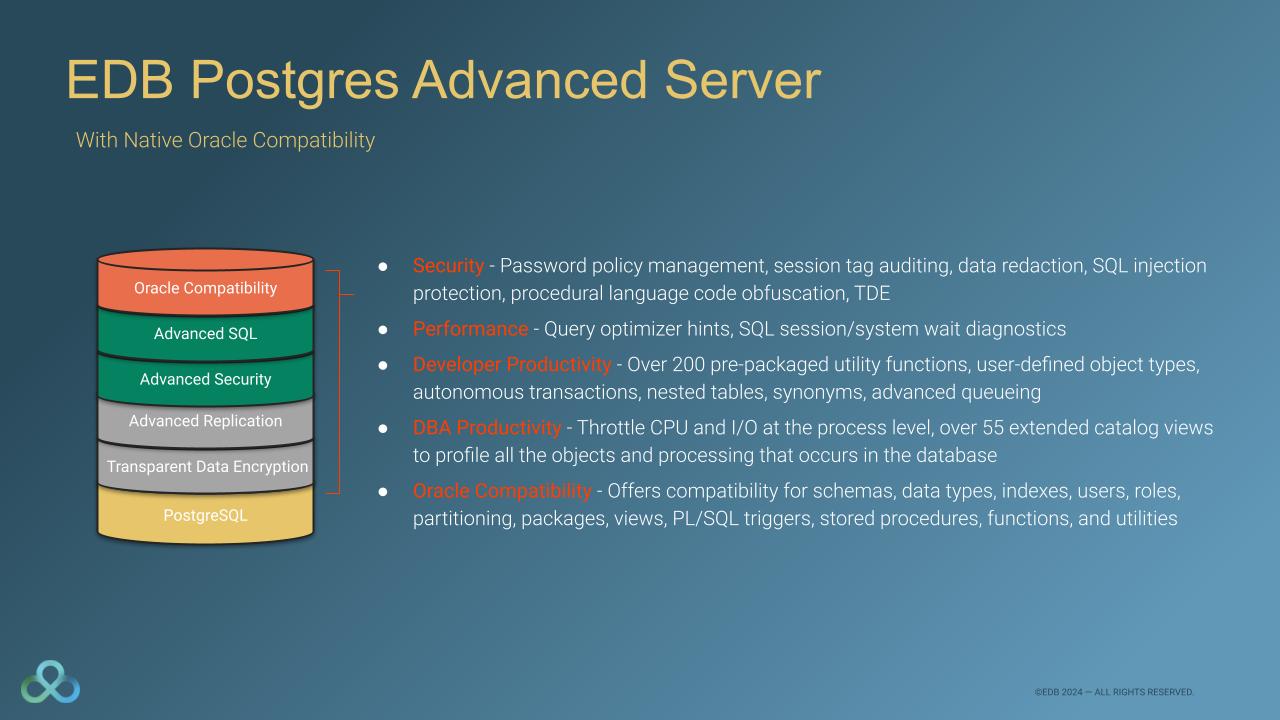
The experts at EDB have also leveraged the extensibility of Postgres to create a version that understands Oracle's language natively via an extension. Just like JSON is an extension. Key value pair is an extension. GIS is an extension. Vectors are extensions.
A large Postgres talent pool
Because of the massive popularity of Postgres, there’s also an immense talent pool of Developers who know Postgres and want to build and develop new applications with Postgres. In the last release of Postgres, more than 100 companies and more than 400 individuals contributed. Companies who choose Postgres as their database solution will have no shortage of talented developers to help accelerate their business.
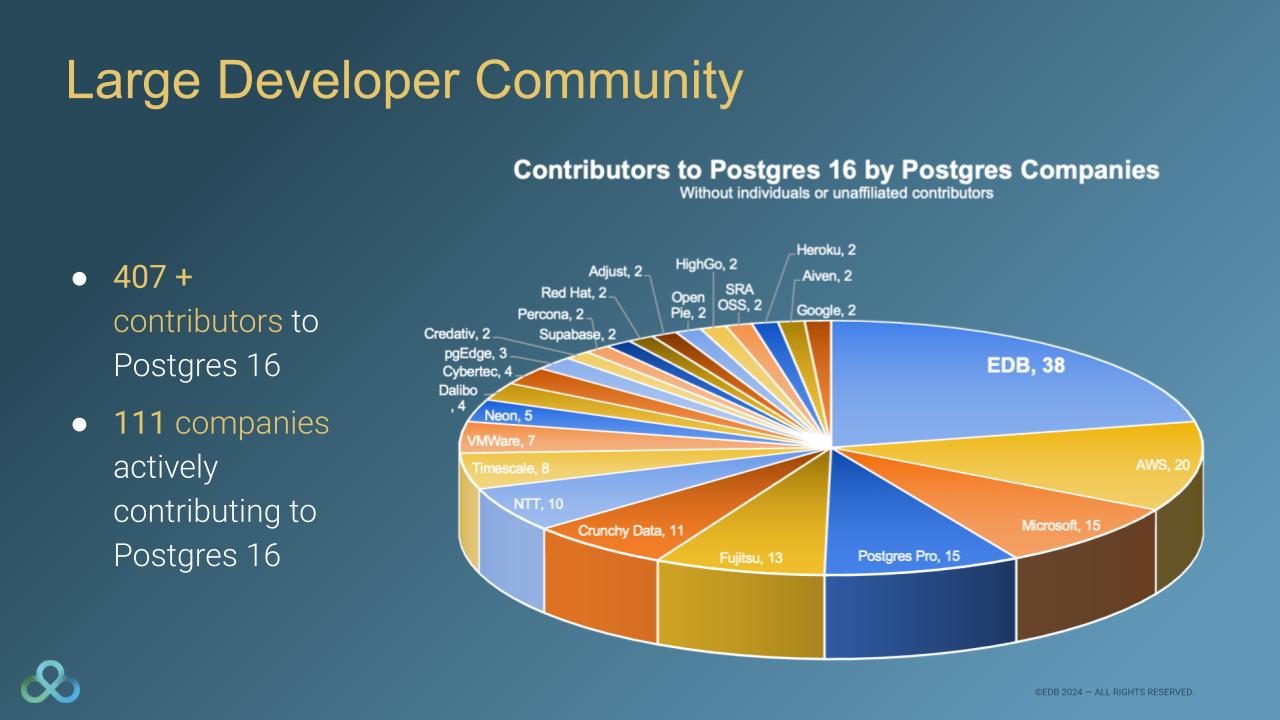
It’s remarkable to see all the different companies that play a role in building Postgres. EDB is proud to be part of the vibrant open source community. From DBAs and other individual contributors, to whole companies like EDB, there is a massive and talented community of Postgres experts all around the world that can create and support the next wave of data innovation.
With these impressive numbers, there is no need to worry about the talent that you need to drive the transformation.
At EDB, we believe that the AI generation is a world in which Postgres is meant to thrive.
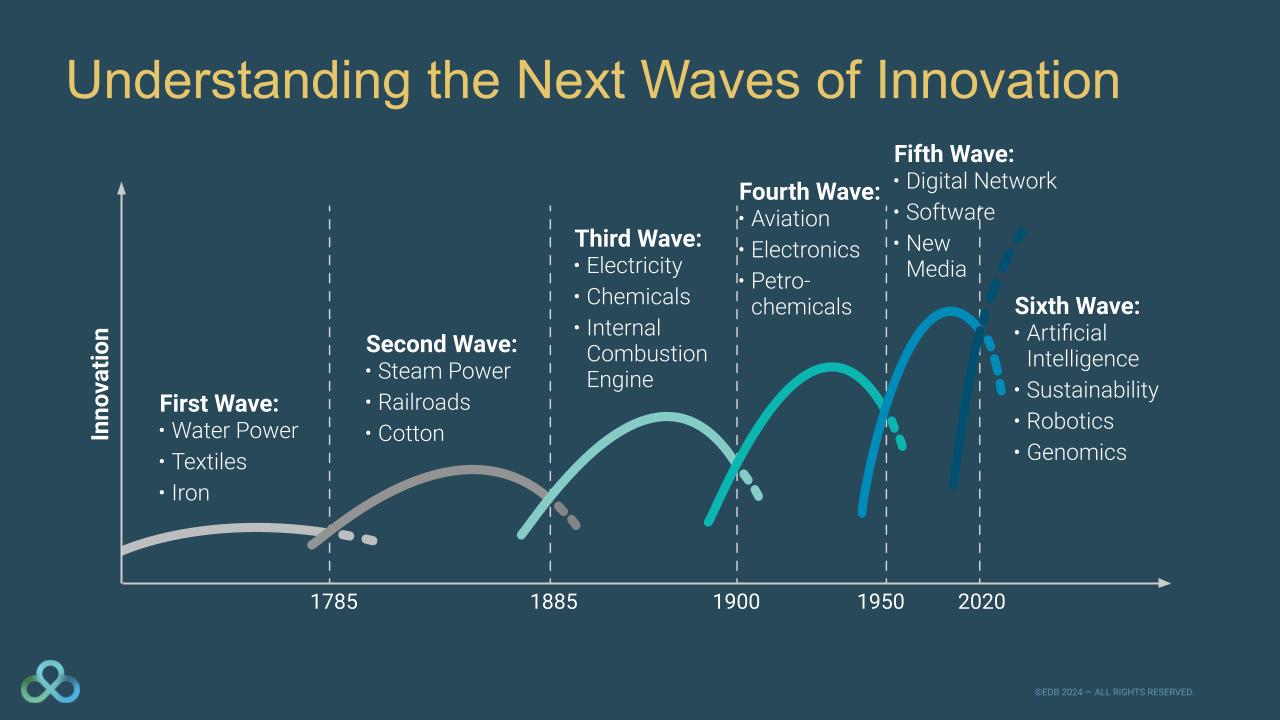
As the leading Postgres company, EDB knows that AI and analytics are the next wave of innovation. We are working hard to expand Postgres for transactional, analytical and AI workloads. Because Postgres can already can do many of these things successfully, we are confidently building the future of the best data platform for the enterprise.
Postgres has been around for more than 30 years years, and yet it’s more popular than ever, as companies around the world leverage the flexibility, extensibility, and affordability of open source. And EDB is more dedicated than ever to building the future of the AI economy with Postgres.
Learn more about EDB Postgres AI here.
